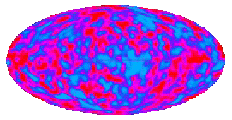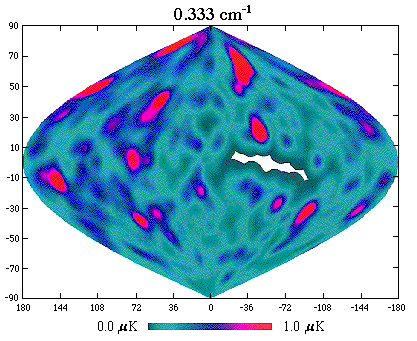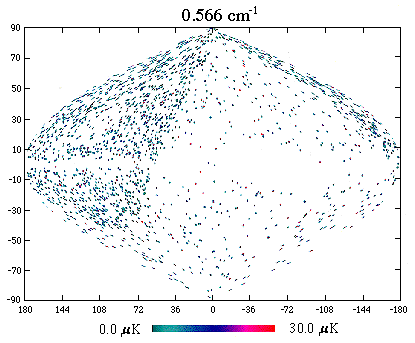
 CONTRIBUTION
OF
EXTRAGALACTIC
RADIO
SOURCES
TO
COSMIC
MICROWAVE
BACKGROUND
ANISOTROPY
CONTRIBUTION
OF
EXTRAGALACTIC
RADIO
SOURCES
TO
COSMIC
MICROWAVE
BACKGROUND
ANISOTROPY
| Abstract | Introduction | Radio Sources | Analysis | Conclusion |
![]()
We present skymaps of the estimated contribution of extragalactic radio sources to the sky temperature over the relevant range of frequencies (30-200 GHz) needed to predict the resultant level of confusion of Cosmic Microwave Background (CMB) anisotrophy measurements. CMB anisotropy observations at high resolution are especially sensitive to this foreground. We predict skymaps of extragalactic radio sources at instrument subdegree resolutions. We describe the databases and the modeling routines used to extrapolate/interpolate to the relevant frequencies. Analysis of the temperature anisotropy of these skymaps will provide limits of observational windows available for medium and small-angular scale CMB anisotropy measurements.

The COsmic Microwave Background Explorer (COBE) detection of large angular CMB anisotropy has sparked a new drive for measuring the anisotropy on much smaller angular scales with the attempt to determine crucial information on the nature of dark matter, the existence of topological defects and the imprints left on the CMB by gravitational effects. Estimates of extragalactic foreground confusion (contamination) are becoming more important as many ground-based and balloon-borne as well as satellite experiments (Microwave Anisotropy Probe, Max Planck Surveyor) have recently been developed or proposed to study CMB anisotropies at these angular scales. COBE maps were basically unaffected by extragalactic sources because of its large beam size 7 degrees. However at smaller angular resolutions, the contribution of point sources increases thus making observations more sensitive to extragalactic foregrounds. This includes radio galaxies, bright infrared galaxies and the Sunyaev-Zeldovich effect. Our purpose here is to estimate the contribution of discrete extragalactic radio sources to the CMB fluctuations on small angular scales: 1/6 a degree, 1/2 a degree, 1 degree. To evaluate their effect on anisotropy measurements, we used flux data from a variety of surveys including very recent ones, to construct models of source emission (spectra) as a function of frequency and angular resolution based on a spline/line best fit procedure. To simulate balloon and satellite observations, we convolve all sources on pixelized skymaps. The resultant maps are analyzed to determine the expected contribution of radio galaxies to foreground confusion of CMB anisotropy. This information will be very useful when choosing frequencies and regions of the sky to observe CMB fluctuations on small angular scales.
![]()
A major portion of this project included updating a catalog of radio sources in the sky. We have been able to compile a list of fluxes for multiple frequencies for 2500 sources, making our catalog one of the most comprehensive databases on radio sources. A FORTRAN program was written to automatically plot/print these sources paying attention to the errors in the measurements and flux variability. Figure 1. shows a plot of the hi/low frequency flux ratios for the bright (circles) and dim sources (squares). One can notice that there is clumping of bright sources with steep spectra. A current version of the catalog is available for viewing and may prove useful for analyzing radio galaxy spectra.
Figure 1- Flux ratio of 90 GHz/10 GHz vs. 10 GHz/1.4 GHz (Circles represent bright sources at 1.4 GHz; squares represent dim sources at 1.4 GHz.)

| Ignored Frequency [GHz] | Extrapolated Error [%] | Extrapolated Error Factor |
|---|---|---|
| > 2 | 209 | 2.46 |
| > 10 | 148 | 2.28 |
| > 20 | 133 | 1.96 |
| > 90 | 92 | 1.57 |
Figure 2- Sample of spectra for 8 radio sources.

![]()

![]()
| FWHM | 30 GHz | 50 GHz | 90 GHz | 200 GHz | 230 GHz | 300 GHz |
|---|---|---|---|---|---|---|
| 1/6o | 5.626e-5 | 2.28e-5 | 5.84e-6 | 3.36e-6 | 3.96e-6 | 5.78e-6 |
| 1/2o | 3.43e-5 | 1.28e-5 | 3.24e-6 | 1.86e-6 | 2.03e-6 | 2.98e-6 |
| 1o | 1.72e-5 | 6.43e-6 | 1.82e-6 | 9.50e-7 | 1.02e-6 | 1.50e-6 |
| 10o | 2.27e-6 | 8.70e-7 | 2.55e-7 | 1.41e-7 | 1.55e-7 | 2.26e-7 |
Figure 3- Sky map in galactic coordinates at 90 GHz convolved with a 10o beam. Areas of white represent regions in the sky where we lack data on sources.

Figure 4- Sky map in galactic coordinates at 90 GHz convolved with a 1/2o beam. Notice the biased distribution (Northern Hemisphere).

Figure 5- Confusion from extragalactic radio foreground anisotropy. Log-log plot of DT/T vs. frequency for instrument resolutions of 1/6o, 1/2o, 1o, and COBE (10o).

![]()
Our analysis of the fitted spectra of provides us with an average extrapolation error which we can use to make systematic corrections to our flux predictions. The maps produced in this project set a lower limit on the confusion to CMB, but nevertheless bring attention to the fact they are going to be a major issue for future small resolution CMB anisotropy observations. Future work is going to be concentrated on expanding our catalog, especially in the southern hemisphere, in an attempt to make our analysis more complete.
If you have questions or comments contact me at rem@einstein.ruph.cornell.edu.